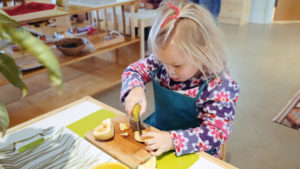Primary Program
A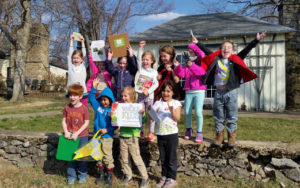 t Mountainside Montessori, a Primary class is a joyful, peaceful community of children from 3 to 6 years old. The younger children are guided by the teacher and learn by observing and working with older students. The older children learn leadership and compassion by being role models for the younger students in this mixed-aged setting. Children are given individual, sequenced lessons designed to increase their skills and independence. After they have been introduced to the various activities and materials, children enjoy choosing their own work freely, following their interests.
t Mountainside Montessori, a Primary class is a joyful, peaceful community of children from 3 to 6 years old. The younger children are guided by the teacher and learn by observing and working with older students. The older children learn leadership and compassion by being role models for the younger students in this mixed-aged setting. Children are given individual, sequenced lessons designed to increase their skills and independence. After they have been introduced to the various activities and materials, children enjoy choosing their own work freely, following their interests.
THE THREE-YEAR PRIMARY PROGRAM FOCUSES ON THE FOLLOWING AREAS:
Practical Life
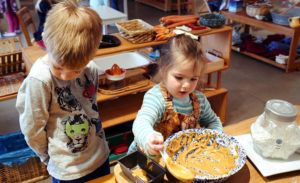 This area consists of exercises in caring for the child’s own person, exercises in caring for the environment (both indoors and out), exercises in social etiquette known as “Grace and Courtesy,” and exercises to develop equilibrium and full body control. The purpose of all Practical Life work is to help children develop independence, concentration, and control of movement. These attributes allow the child to develop into a confident and responsible citizen of the world. The Practical Life activities lay a strong foundation for later work in all areas in the curriculum.
This area consists of exercises in caring for the child’s own person, exercises in caring for the environment (both indoors and out), exercises in social etiquette known as “Grace and Courtesy,” and exercises to develop equilibrium and full body control. The purpose of all Practical Life work is to help children develop independence, concentration, and control of movement. These attributes allow the child to develop into a confident and responsible citizen of the world. The Practical Life activities lay a strong foundation for later work in all areas in the curriculum.
Sensorial
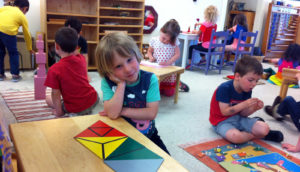 These materials are designed as “keys” to the everyday, physical world. Each material isolates a particular sensory input or experience. Through working with these materials, the children educate and refine their visual, auditory, tactile, gustatory, and olfactory senses. In the sensorial area, children gain a keen awareness of and appreciation for the environment in which they live. These activities also contain many indirect preparations for later work in language and mathematics. By working with these materials, not only are the child’s fingers, hand, and arm being prepared for writing, but these materials allow children to experience all kinds of groupings, sets, sequences, and geometrical patterns in visual and tactile ways.
These materials are designed as “keys” to the everyday, physical world. Each material isolates a particular sensory input or experience. Through working with these materials, the children educate and refine their visual, auditory, tactile, gustatory, and olfactory senses. In the sensorial area, children gain a keen awareness of and appreciation for the environment in which they live. These activities also contain many indirect preparations for later work in language and mathematics. By working with these materials, not only are the child’s fingers, hand, and arm being prepared for writing, but these materials allow children to experience all kinds of groupings, sets, sequences, and geometrical patterns in visual and tactile ways.
Mathematics
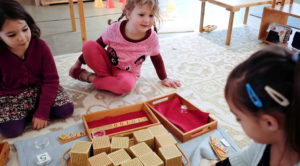 The children are first introduced to mathematics via the sensorial materials, where they experience such fundamental mathematical concepts as length, volume, gradation, sequencing, and grouping, in a concrete way. With this strong foundation established, children then learn the numbers 1-10, which they again experience in a hands-on manner. After that, children explore the four operations of arithmetic: addition, subtraction, multiplication and division (using up to four-digit numbers), by manipulating specifically designed Montessori mathematical materials. By the end of their time in Primary, Montessori children have been exposed to concepts such as area, fractions, algebra, and geometry, in addition to the four arithmetic operations.
The children are first introduced to mathematics via the sensorial materials, where they experience such fundamental mathematical concepts as length, volume, gradation, sequencing, and grouping, in a concrete way. With this strong foundation established, children then learn the numbers 1-10, which they again experience in a hands-on manner. After that, children explore the four operations of arithmetic: addition, subtraction, multiplication and division (using up to four-digit numbers), by manipulating specifically designed Montessori mathematical materials. By the end of their time in Primary, Montessori children have been exposed to concepts such as area, fractions, algebra, and geometry, in addition to the four arithmetic operations.
Language
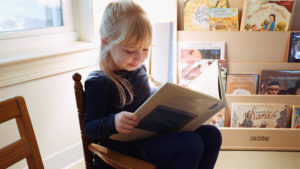 Primary children are eagerly acquiring language, both in size of vocabulary and complexity of expression. As such, the Primary language curriculum focuses on cultivating both spoken and written language. Through various oral sound games, children develop the awareness that words are composed of individual sounds. The Sandpaper Letters then allow the child to learn the sounds and shapes of these letters of the alphabet, tracing the shapes using the same hand movements they will later use to write. Older children choose letters from the Moveable Alphabet to “write” their own stories, even before their hands are able to easily direct a pencil. Children are eager to express themselves, and often find through writing their own sentences that they are suddenly and spontaneously able to read their own compositions—and others’. As their reading abilities develop, children explore the grammatical components of sentences, and begin categorizing words according to their grammatical function. At the end of their time in the Primary, Montessori-educated children routinely enter first grade as fully competent readers and writers.
Primary children are eagerly acquiring language, both in size of vocabulary and complexity of expression. As such, the Primary language curriculum focuses on cultivating both spoken and written language. Through various oral sound games, children develop the awareness that words are composed of individual sounds. The Sandpaper Letters then allow the child to learn the sounds and shapes of these letters of the alphabet, tracing the shapes using the same hand movements they will later use to write. Older children choose letters from the Moveable Alphabet to “write” their own stories, even before their hands are able to easily direct a pencil. Children are eager to express themselves, and often find through writing their own sentences that they are suddenly and spontaneously able to read their own compositions—and others’. As their reading abilities develop, children explore the grammatical components of sentences, and begin categorizing words according to their grammatical function. At the end of their time in the Primary, Montessori-educated children routinely enter first grade as fully competent readers and writers.
Cultural Studies
 Cultural studies are embedded into the Montessori Primary environment. The classroom itself contains a wide variety of pictures and artifacts from geographically diverse cultures, which are frequently used in cultural lessons. Through stories, songs and celebrations, children experience the diversity of international cultures. The very young children are introduced early to a sandpaper globe, which provides a visual and tactile experience of the Earth. Children use other sensorial materials – puzzle maps – to explore the continents of our world, the countries of each continent, and the states of our own country. Children are given the geography vocabulary associated with these maps both orally and through prepared nomenclature cards that the children use as an integrated part of their language work. They also create miniature versions of key land and water forms such as lake, island, and peninsula, and work with miniature flags representing a wide variety of nation states.
Cultural studies are embedded into the Montessori Primary environment. The classroom itself contains a wide variety of pictures and artifacts from geographically diverse cultures, which are frequently used in cultural lessons. Through stories, songs and celebrations, children experience the diversity of international cultures. The very young children are introduced early to a sandpaper globe, which provides a visual and tactile experience of the Earth. Children use other sensorial materials – puzzle maps – to explore the continents of our world, the countries of each continent, and the states of our own country. Children are given the geography vocabulary associated with these maps both orally and through prepared nomenclature cards that the children use as an integrated part of their language work. They also create miniature versions of key land and water forms such as lake, island, and peninsula, and work with miniature flags representing a wide variety of nation states.
Art
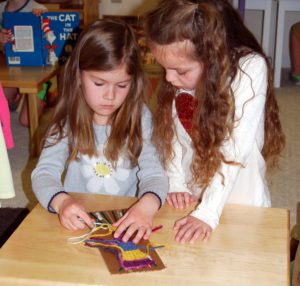 In the Primary classroom, children choose art activities from the art shelf according to their interests. These art materials progress from simple to complex as the child’s skills develop. The Montessori environment encourages children to express their knowledge and interests artistically, using the skills they have learned from the art materials. Children may illustrate their written story, or trace the puzzle piece of a continent they have just learned about. From the art shelf, children learn such activities as cutting, pasting, collage, coloring (using crayons, pastels, charcoal), painting, watercolor, clay work, sewing and embroidery.
In the Primary classroom, children choose art activities from the art shelf according to their interests. These art materials progress from simple to complex as the child’s skills develop. The Montessori environment encourages children to express their knowledge and interests artistically, using the skills they have learned from the art materials. Children may illustrate their written story, or trace the puzzle piece of a continent they have just learned about. From the art shelf, children learn such activities as cutting, pasting, collage, coloring (using crayons, pastels, charcoal), painting, watercolor, clay work, sewing and embroidery.
Music
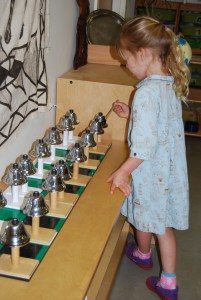 Music is a vibrant, daily part of the Primary classroom. In addition to singing songs, listening to music and playing rhythm instruments, Primary children use the Montessori Bells. This material is initially a sensorial material designed so that children can match and grade all pitches on both diatonic and chromatic scales during the sensitive period for pitch development. The material is then used to play scales and musical phrases, and can be accompanied by the voice. Through this material, children gain a keen awareness and ability to discriminate between pitches. In addition to exploration with the Bells, children are told stories of prominent composers’ lives while listening to selections from the works of these composers, incorporating elements of both history and geography into the lesson.
Music is a vibrant, daily part of the Primary classroom. In addition to singing songs, listening to music and playing rhythm instruments, Primary children use the Montessori Bells. This material is initially a sensorial material designed so that children can match and grade all pitches on both diatonic and chromatic scales during the sensitive period for pitch development. The material is then used to play scales and musical phrases, and can be accompanied by the voice. Through this material, children gain a keen awareness and ability to discriminate between pitches. In addition to exploration with the Bells, children are told stories of prominent composers’ lives while listening to selections from the works of these composers, incorporating elements of both history and geography into the lesson.
Science
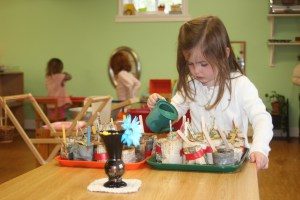 Practical life and sensorial activities at the Toddler and Primary levels lay a strong foundation for later work in scientific classification and experimentation. In both of these areas, children learn key scientific skills such as measuring, comparing, classifying, and keen observing. This work is accompanied by extensive classified nomenclature. For example, Primary age children learn the scientific nomenclature of the parts of a flower, such as the calyx and corolla. Children also study the basic characteristics and nomenclature of plants and animals. They learn to name common domestic and wild plants and animals, and they work with materials to learn fundamental classifications such as mammals, birds, reptiles, amphibians, and fish. Non-fiction books related to science are read aloud to the children, and they have classroom responsibilities to care for the indoor plants, as well as feed the birds outside. The children also plant, tend to, and harvest their own classroom gardens.
Practical life and sensorial activities at the Toddler and Primary levels lay a strong foundation for later work in scientific classification and experimentation. In both of these areas, children learn key scientific skills such as measuring, comparing, classifying, and keen observing. This work is accompanied by extensive classified nomenclature. For example, Primary age children learn the scientific nomenclature of the parts of a flower, such as the calyx and corolla. Children also study the basic characteristics and nomenclature of plants and animals. They learn to name common domestic and wild plants and animals, and they work with materials to learn fundamental classifications such as mammals, birds, reptiles, amphibians, and fish. Non-fiction books related to science are read aloud to the children, and they have classroom responsibilities to care for the indoor plants, as well as feed the birds outside. The children also plant, tend to, and harvest their own classroom gardens.
Daily Work
During a three-hour block every morning, Primary children are engaged in a wide variety of work. They may practice skills to care for themselves or the classroom or work on writing words or stories. Some children may work together to solve a large equation with manipulative math materials. Others may care for plants by watering the soil or washing the leaves. The Montessori materials, joyfully presented and freely chosen, create a strong foundation for reading, writing, creativity, critical thinking and participation in an active, diverse community. By the time children have completed three years in Primary, they have become poised, proud, and compassionate leaders for the younger children. They have learned to think for themselves, approach learning with joy, and self-regulate their emotions for social harmony.

